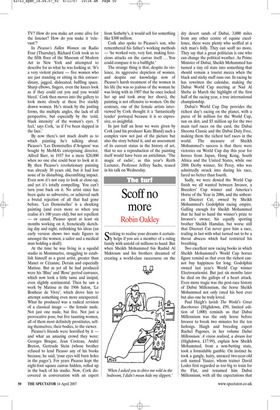Shocking women
Kate Chisholm
It was not so extraordinary in September 1946 when the Third Programme began broadcasting that its schedule should include a weekly discussion of the ‘visual arts’, kicking off with the then director of the National Gallery in conversation with the painter William Coldstream. Radio was still the Queen Bee of the BBC and television a young upstart whose potential was not yet fully understood. The ‘alert and receptive’ listeners of the Third Programme were expected to pay attention and work at their listening so that they could conjure for themselves flickering images of what was being talked about on air. But now, when television has become so sophisticated, so dazzling, so brazenly colourful, it’s an audacious radio producer who decides to make a programme about one of the most famous paintings in the history of art with just a mike and a cast of experts. How can you compete with the digital, crystal-clear trickery of flat-screen TV? How do you make art come alive for the listener? How do you make it ‘relevant’?
In Picasso’s Fallen Women on Radio Four (Thursday), Richard Cork took us to the fifth floor of the Museum of Modern Art in New York and attempted to describe for us what he was looking at. ‘It’s a very violent picture — five women who are just standing or sitting in this extraordinary, jagged, dislocated, baffling space. Sharp elbows, fingers, even the knees look as if they could cut you and you would bleed.’ Cork then moves into the gallery to look more closely at these five starkly drawn women. He’s struck by the jostling forms, the multiple angles, the lack of all perspective, but especially by the ‘cold, black intensity’ of the women’s eyes. ‘I feel,’ says Cork, ‘as if I’ve been slapped in the face.’ By now there’s not much doubt as to which painting he’s talking about. Picasso’s ‘Les Demoiselles d’Avignon’ was bought by MoMA’s enterprising director, Alfred Barr, in 1937 for a mere $28,000 when no one else could bear to look at it. By then Picasso’s revolutionary painting was already 30 years old, but it had lost none of its disturbing, discomfiting impact. Even now it’s not easy to look at close-up, and yet it’s totally compelling. You can’t turn your back on it. No artist since has been quite so subversive, or achieved such a brutal rejection of all that had gone before. ‘Les Demoiselles’ is a shocking painting (and even more so when you realise it’s 100 years old), but not repellent — or casual. Picasso spent at least six months working on it, frenetically sketching day and night, rethinking his ideas (an early version shows two male figures in amongst the women, a sailor and a medical man holding a skull).
At the time he was living in a squalid studio in Montmartre, struggling to establish himself as a great artist, greater than Manet or Cézanne, Derain and especially Matisse. But as yet all he had produced were his ‘Blue’ and ‘Rose’ period canvases, which now look a little tame and insipid, even slightly sentimental. Then he saw a work by Matisse in the 1906 Salon, ‘Le Bonheur de Vivre’, which drove him to attempt something even more unexpected. What he produced was a radical revision of a classical image — the female nude. Not just one nude, but five. Not just a provocative pose, but five taunting women, all of them most definitely prostitutes, selling themselves, their bodies, to the viewer.
Picasso’s friends were horrified by it and what an amazing crowd they were: Georges Braque, Jean Cocteau, André Breton, Gertrude Stein (whose brother refused to lend Picasso any of his books because, he said, ‘your eyes will burn holes in the pages’). For years Picasso kept the eight-foot square canvas hidden, rolled up in the back of his studio. Now, Cork discovered in conversation with an expert from Sotheby’s, it would sell for something like $300 million.
Cork also spoke to Picasso’s son, who remembered his father’s working methods — ‘he worked very, very fast, making ferocious attacks on the canvas itself... You could compare it to a bullfight.’ The strange thing is that, despite its violence, its aggressive depiction of women, and despite our knowledge now of Picasso’s harsh treatment of the women in his life (he was so jealous of the woman he was living with in 1907 that he once locked her up and took away her shoes), the painting is not offensive to women. On the contrary, one of the female artists interviewed by Cork thought it a ‘fantastically tender’ portrayal because it is so expressive, so insightful.
In just half an hour we were given by Cork (and his producer Kate Bland) such a complex view not just of the picture but also the story behind it, and an assessment of its current status in the history of art, that to see a reproduction of the painting itself would have been an anticlimax. ‘The magic of radio’, as this year’s Reith Lecturer, Professor Jeffrey Sachs, teased in his talk on Wednesday.



































































 Previous page
Previous page